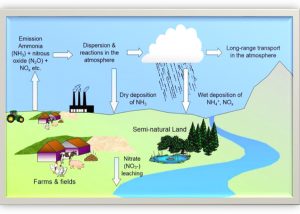
By Muhammad Bakhsh, University of Veterinary and Animal Sciences (UVAS), Jhang Campus and Sumaira Ali Sumaira Ali, Shaheed Benazir Bhutto University of Veterinary and Animal Sciences (SBBU-VAS), Sakrand, Sindh
In epidemiology, an outbreak is an unexpected extends in occurrence of a disease in a precise time and place. It may additionally have an effect on a small and localized team or have an effect upon hundreds of humans. Four linked instances of an uncommon infectious ailment might also be adequate to represent an outbreak. Outbreaks consist of few elements like epidemics, time period commonly used for infectious diseases, ailments related with an environmental origin, such as a water or food borne diseases. Pandemics are near-global sickness outbreaks when more than one nation throughout the world is infected.
Disease outbreaks are usually caused by an infection, transmitted through person-to-person contact, animal-to-person contact or from the environment or other media.
Investigations of Disease Outbreak
The primary reason for engaging in outbreak investigations is to perceive the source so as to establish control and to institute measures to prevent future episodes of disease. They are also once in a while undertaken to educate new personnel or to learn the mechanism for transmission. Whether a scourge investigation could be conducted may also be influenced via the severity of the disease, the capacity for spread, the provision of resources and by way of political concerns or the extent of challenge among the general public.
Epidemiological Investigation of Disease
Following are the steps involved to investigate a disease:
• Verification of the diagnosis
• Confirmation of existence of outbreak
• Defining population at risk
• Rapid search for cases and characteristics
• Data analysis (Time, Place and Person)
• Formulation of hypothesis
• Evaluation of ecological factors
• Further investigations
• Reporting
Control and Preventive Measures
Control measures are determined by the results of initial analysis in consultation with appropriate professionals. They will vary depending on the agent, the mode of transmission and observation. Public health officials may decide on control measure based on strong epidemiological evidence of the disease’s origin, spread and development. They do not require proof of contamination from the laboratory. This practice can result in earlier action to protect the public health.
Outbreak of a disease can be controlled by appropriate preventive measures which include
• Good site planning
• Provision of basic clinical services
• Increase the resistance of host
• Inactivating the pathogen agents
• Control on the speared of infection including Isolation, quarantine, segregation and personal surveillance.
• Provision of appropriate shelter
• Clean water supply
• Sanitation
• Vaccination against specific disease
• Regular and sufficient food supply
• Control of vector
• Stay at home if you have a signs and symptoms of an infection.
• Do not share your personal item
• Get vaccinated to increase the immunity
Extra cleaning and domestic staff may be required during and immediately following the outbreak. Guidance on the decontamination of affected areas will be determined. It may be necessary to order and purchase additional personal protective equipments. If specialist respiratory equipment is required, then access to fit-testing and training will also be necessary.
• It may also be necessary to purchase additional supplies of cleaning equipment to facilitate terminal cleaning of the environment.
• In outbreak situations it may be necessary to close a ward or care unit. This recommendation will be guided by a risk assessment carried out by the Infection Prevention Control.
• Hand hygiene is the single and most important part of infection control. Hand washing before any contact with patients, after any activity that contaminates the hands and after removing protective clothing.
• Use of Personal Prospective Equipment: gloves, aprons, eye protection, face masks etc.
• Handle and dispose of sharp materials safely
• Dispose the contaminated waste safely
• Managing blood and body fluids including spillages and transport of specimens carefully
• Maintain a clean and clinical environment
Cholera, bubonic plague, smallpox, and influenza are some of the most brutal killers in human history. Outbreaks of these diseases across international borders, are properly defined as pandemic, especially smallpox, which throughout history, has killed between 300-500 million people in its 12,000 year existence. The most recent outbreak is of Corona Virus which is spreading to the whole world. It must be controlled by these measures otherwise it can spread drastically on our planet.







